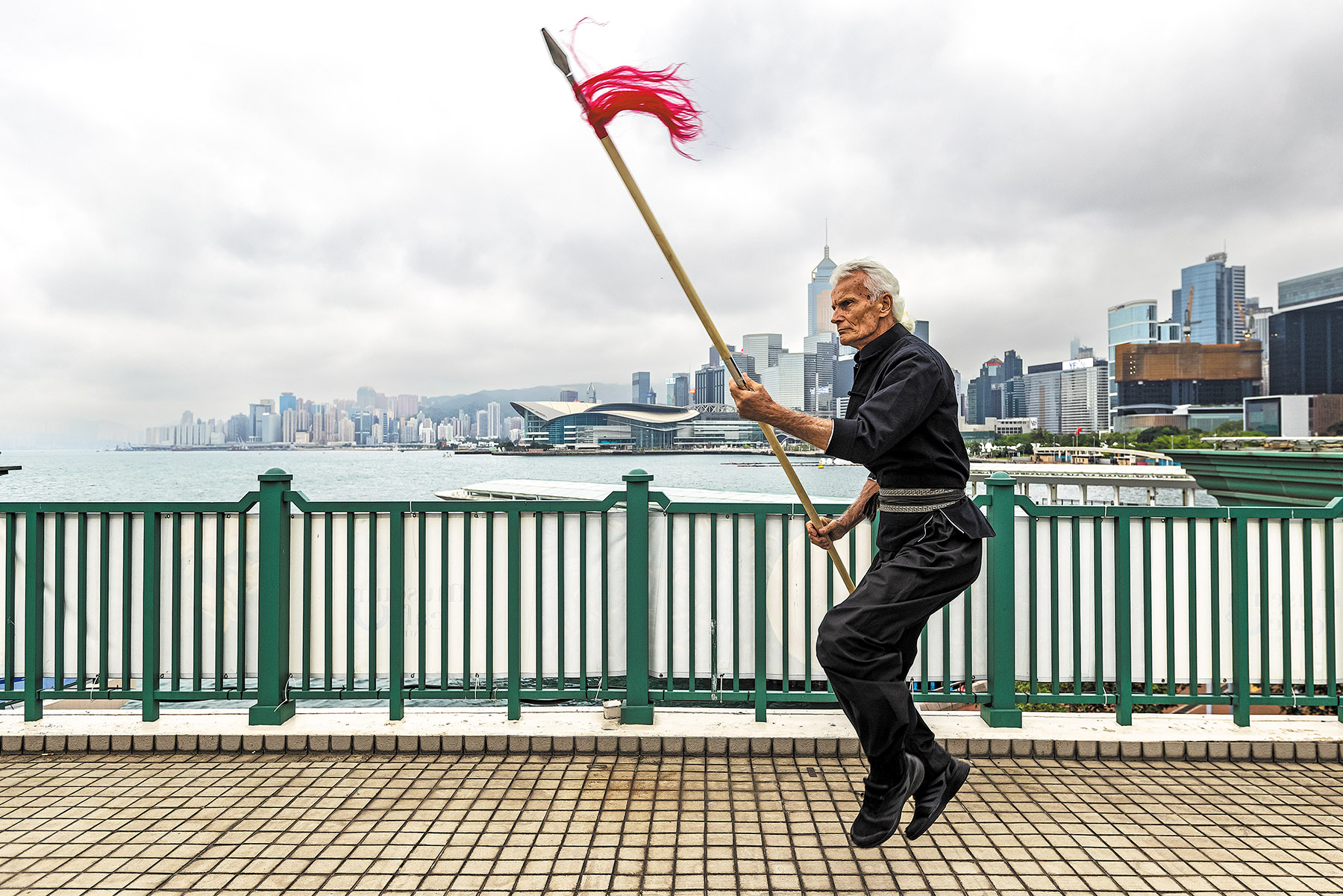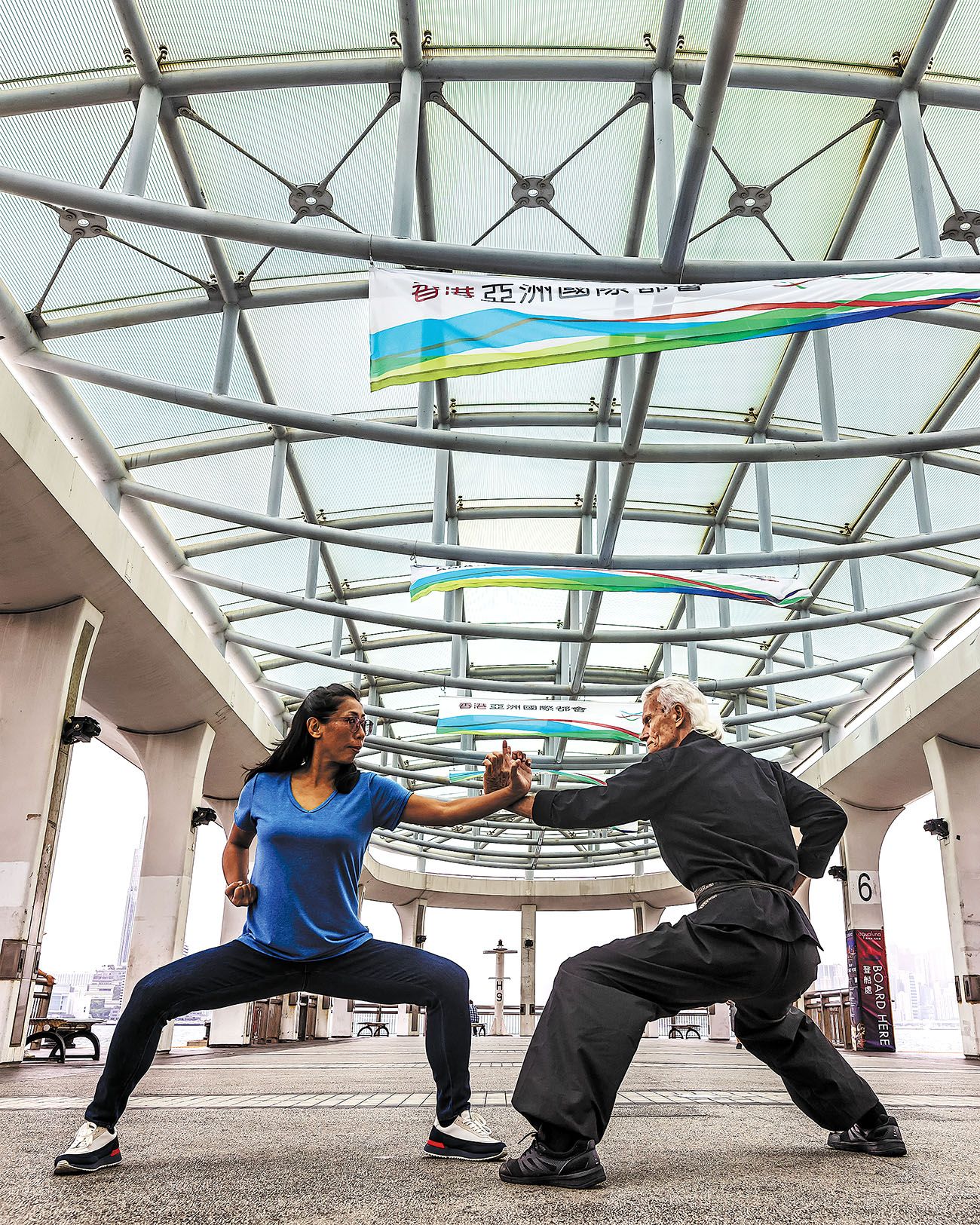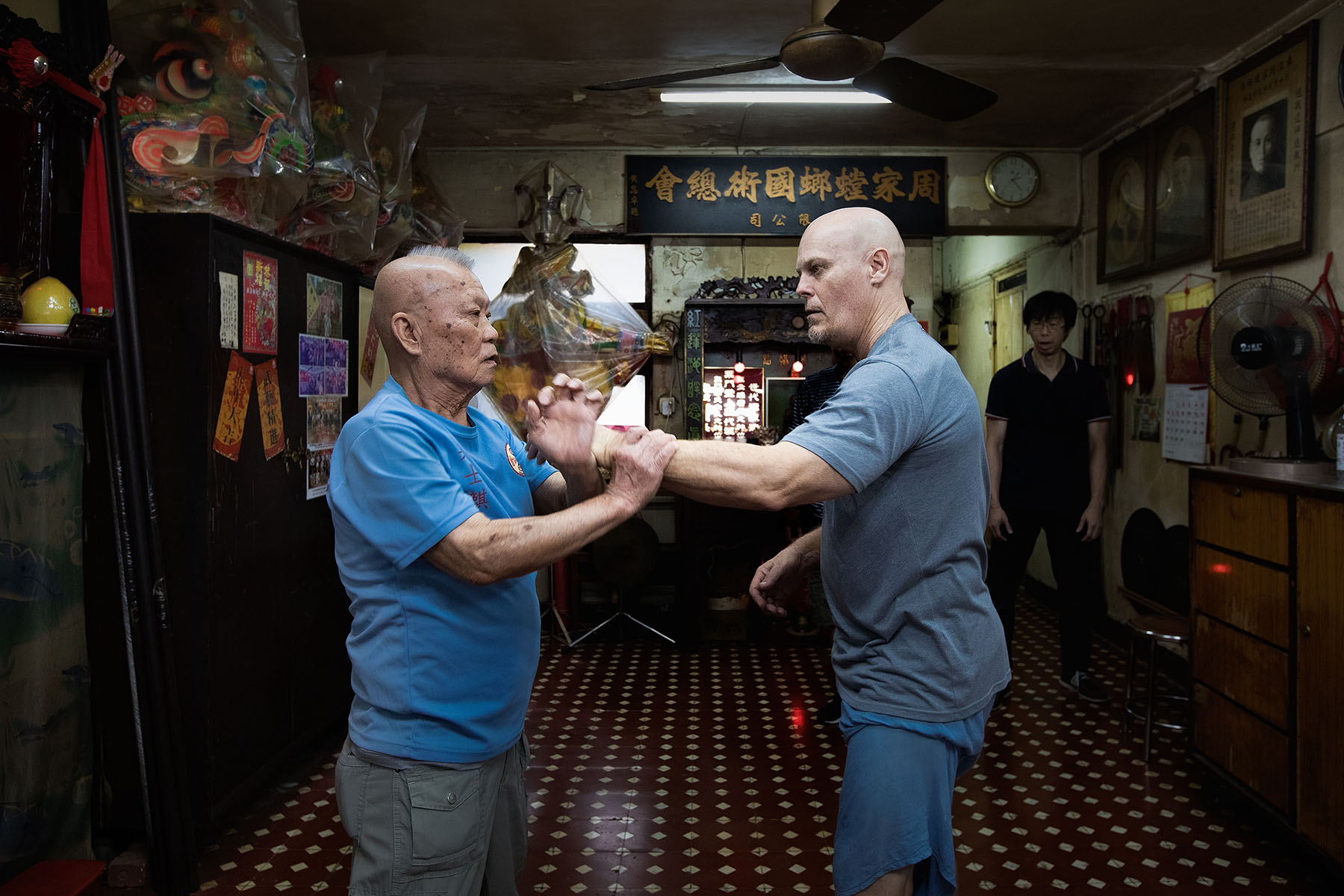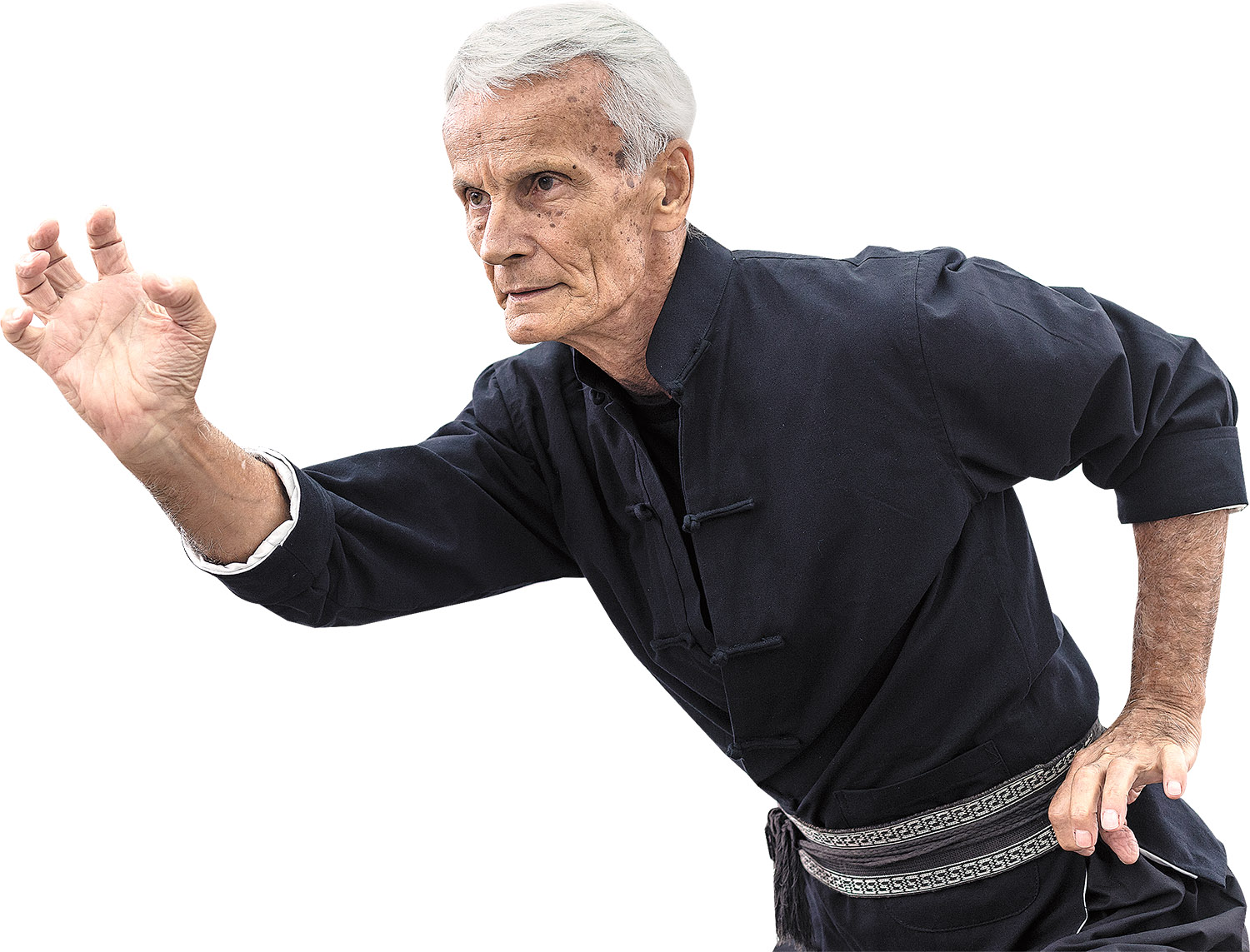Hong Kong remains hub for learning, teaching traditional Chinese martial arts

On Hong Kong's Lantau Island, 77-year-old Gam Bok-Yin swiftly moves his fists and legs as he demonstrates the techniques of Hung Gar, a style of Chinese kung fu.
The Australian has his long white hair tied in a knot and is dressed in traditional Chinese attire. Behind him, dozens of Chinese students copy his moves, as they learn their own fighting traditions from a foreigner.
Gam has spent over six decades studying Hung Gar, or Hung Kuen, a centuries-old southern Chinese martial art, characterized by strong hand techniques, such as "bridge hand" and "tiger claw".
READ MORE: Kung fu contest helps foster cultural exchange
His connection to Hung Gar goes back to the 1940s in Sydney, Australia, when it gave him a second chance in life.
Gam, who also goes by the name Graham Player, was born with a disability that baffled his father and uncle, both medical doctors trained in Western medicine. He said he was put in a wheelchair and his hip was immobilized by a plaster cast that went from his waist to the bottom of his right leg.
"That's how the Western medical treatment remained for many years until I was 5 years old," he said.
An operation was suggested, but Gam rejected the idea as he was warned it might leave him with a limp.
Unexpectedly, a Chinese neighbor offered to help the young boy and asked Gam to copy leg movements and simple exercises he showed him.
Within just a few days, Gam said he experienced a remarkable change, and sensed feeling in his legs for the first time.
He persisted with the training. By the age of 8 he could take his first steps, and by the time he was 12 he could walk normally.

Eastern exposure
One day, Gam accompanied his neighbor to Sydney's Chinatown and was astonished to witness many people practicing the very same training techniques he had learned.
His neighbor told Gam that the practice was called Hung Gar, a traditional Chinese martial art from South China with hundreds of years of history.
"Hung Gar is my destiny. I never chose Hung Gar — Hung Gar chose me," Gam said.
He continued studying under his neighbor, until his mentor passed away after 10 years of tutelage.
The neighbor never asked for money, and before he died he told Gam to, "Please carry on the practice and pass it on to others."
In the 1970s, Gam pursued a career as a Chinese medicine practitioner in Australia. However, at the time it was not widely recognized among Westerners. He became a computer engineer and relocated to England where he established his own successful IT company.
He later sold the business for a tidy profit and decided to start a new phase in his life.
Gam moved to Hong Kong to study Hung Gar and became a master's apprentice. However, during a training session the master criticized his tiger claw technique and urged Gam to study the actual movements of the big cat.
After three years he had mastered the technique, but more importantly, he realized that various kung fu styles, such as Northern Praying Mantis, Fujian White Crane, and Fanged Snake, were based on emulating animal movements. These martial arts not only taught practitioners the physical techniques of animals to harness aggression, but also sought to imbue them with the animal's spirit.
As Gam's skills improved, an increasing number of people, primarily Chinese, approached him to learn Hung Gar. He established the Hung Kuen Academy Hong Kong in 1996 and over the decades he has taught hundreds of students, including children and adults, Chinese and foreigners.
However, most people quit soon after starting. They usually complain that practicing martial arts is painful or boring, Gam said.
Traditional martial arts not only provide practitioners with skills and develop qualities such as patience, resilience, and courage, but they can also open a gateway to understanding and inheriting the wisdom of ancestors, Gam said.
Hung Gar is famous for its 12 bridges technique, which involve hardness, softness, forcing, straightness, division, steadiness, inching, lifting, flowing, sending, controlling, and arranging. Gam believes these bridges are not only techniques, but also symbolize distinct personality types.
Learning martial arts empowers people to transition between these different personalities and use the appropriate one when required. Discerning when to be soft and when to be hard, and to adapt accordingly, is a philosophical approach of Chinese kung fu to navigating one's life, Gam said.
Martial arts allow people to inherit past wisdom, cultivate virtue, and discover their roots, Gam said. Even though he is a foreigner, he has vowed to pass on his knowledge of Hong Gar.

In search of the master
Paul Brennan, aged in his 60s, is another Australian who came to Hong Kong to follow his martial arts dreams. He is dedicated to a niche martial art from southern China called Chow Gar Tong Long, which emulates the movements of the praying mantis.
Brennan's Tong Long journey began in the 1970s when he enrolled in a martial arts class, after previously studying South Korean Taekwondo and Japanese judo.
He said unlike the two other martial arts, Tong Long gave him a profound sense of inner calm. "The feeling was amazing," Brennan said.
He continued practicing the martial art and later learned about an esteemed Tung Lung master named Ip Shui living in Hong Kong, whom he was determined to study under.
At that time, Brennan was living in Mt Isa, an Australian mining town. He worked several jobs for three years until late 1991, when he had saved enough money to move to Hong Kong.
However, with no internet or mobile phones back then, locating Master Ip in an unfamiliar city proved difficult. After two months of visiting martial arts schools and making inquiries, Brennan finally discovered Master Ip's whereabouts.
They arranged to meet, but Brennan was worried the master might not accept him as a student. "I came to Hong Kong just for him. If he had rejected me, it would have shattered my life," he said.
Master Ip, who couldn't speak English, relied on his family to communicate with Brennan. After listening to the Australian's story, the master told him that he had retired and was no longer taking new students.
Brennan refused to take no for an answer. He showed the master a sleeping bag he carried at all times and declared: "If you don't accept me, I will sleep on your doorstep. Every morning when you step outside, I will be there, saying 'good morning' until you accept me."
Master Ip chuckled and replied, "all right, you can come."
Brennan settled down in Hong Kong.
He landed a job as a bartender in Tsim Sha Tsui, which gave him more time to practice Tong Long during the day.
Brennan swiftly became aware of the exceptional precision inherent in the techniques shared by the master. However, the language barrier between the two had to be overcome. "Taking classes was like a chicken talking to a duck," Brennan said.
To overcome this obstacle, he wrote down all his inquiries and sought assistance from classmates and also tried his best to learn Cantonese.
Life in Hong Kong was not easy for Brennan. He earned a small salary but needed to support himself and his family in Australia.
"I was willing to endure all hardships. I knew one day I would return to Australia, so I devoted 100 percent of my energy to practicing Tong Long, cherishing every second I spent in Hong Kong, leaving no excuses," he said.
After five years, Brennan left the city and returned to Australia for family reasons.
He found many local martial arts schools that taught Tong Long incorrectly, so he established his own school in his hometown of Brisbane. Every year he returns to Hong Kong and stays for several months to further his study of Tong Long.
Brennan is now fluent in Cantonese and knows numerous classical Chinese names of martial arts techniques.
"In martial arts, language carries a profound cultural significance, with multiple layers of meaning. Each layer of the meaning holds insights that can be traced back thousands of years," he said.
Since founding his school, Brennan has taught thousands of students, but he added that most do not persist with the training. Concerned about the possible disappearance of traditional Chinese martial arts, Brennan has in recent years dedicated himself to helping preserve it by writing books, translating material, and recording videos.
"Chinese martial arts are a real gem, a precious treasure. It would be a great pity if future generations miss out on experiencing their beauty," Brennan said.
Learning martial arts can be painful and arduous. But enduring such challenges can cultivate calmness, understanding, and empathy, and foster a balanced character. "Chinese martial arts make people better," Brennan said, vowing to continue promoting the Chinese tradition.

Traditions preserved
Wilfred Lam Chin-ting, president of the Chin Woo Athletic Association of Hong Kong Ltd, a martial arts organization with a history spanning about 100 years, said that although an exact count is unavailable, many foreigners visit Hong Kong every year to study Chinese martial arts. The COVID-19 pandemic significantly hindered this trend, but there has been a recent gradual resurgence.
These foreign enthusiasts primarily hail from the United States, Europe, Australia, and South Asia. They are attracted by Hong Kong's reputation for preserving the most traditional forms of Chinese martial arts. Wushu practitioners in Hong Kong try their best to safeguard the most classic routines, stances, etiquette, and cultural characteristics associated with their disciplines.
According to Yip Tak-ping, a senior lecturer at the Education University of Hong Kong and president of the Hong Kong History and Culture Society, the popularity of Hong Kong kung fu movies during the last century attracted many foreigners to the city to pursue martial arts training.
After completing their training, many of them returned to their home countries and established their own martial arts schools, becoming key promoters of Chinese martial arts and culture overseas.
These martial arts schools have successfully nurtured multiple generations of students. Despite the declining popularity of Hong Kong kung fu films, these students, influenced by their masters, possess an understanding of Chinese martial arts styles and have a deep appreciation for their origins in Hong Kong.
ALSO READ: Kung fu pilgrimage
Some of them visit Hong Kong to learn kung fu, delve deeper into techniques, and immerse themselves in the rich cultural traditions associated with Chinese martial arts, Yip said.
Foreigners are attracted to Chinese martial arts not only for their physical skills but also for the inherent values kung fu embodies, Yip noted.
Kung fu encompasses a "chivalric spirit" that emphasizes the protection of the weak. It embraces a respect for nature and humanity, rooted in Taoist philosophy. Furthermore, it emphasizes the unity of the body and mind, providing benefits to both physical and mental well-being.
These values possess a universal appeal that transcends national boundaries, regional differences, and the passage of time, Yip emphasized.
To promote Chinese martial arts, it is crucial to recognize the needs of the present and integrate the values of martial arts into a current context, Yip said. This can be achieved through initiatives such as incorporating martial arts into value-based education or mental and physical health programs.
By adapting Chinese martial arts to a contemporary context, their impact can be maximized, enabling more people to benefit from the ancient and enduring wisdom they offer, Yip added.
Contact the writer at oasishu@chinadailyhk.com


